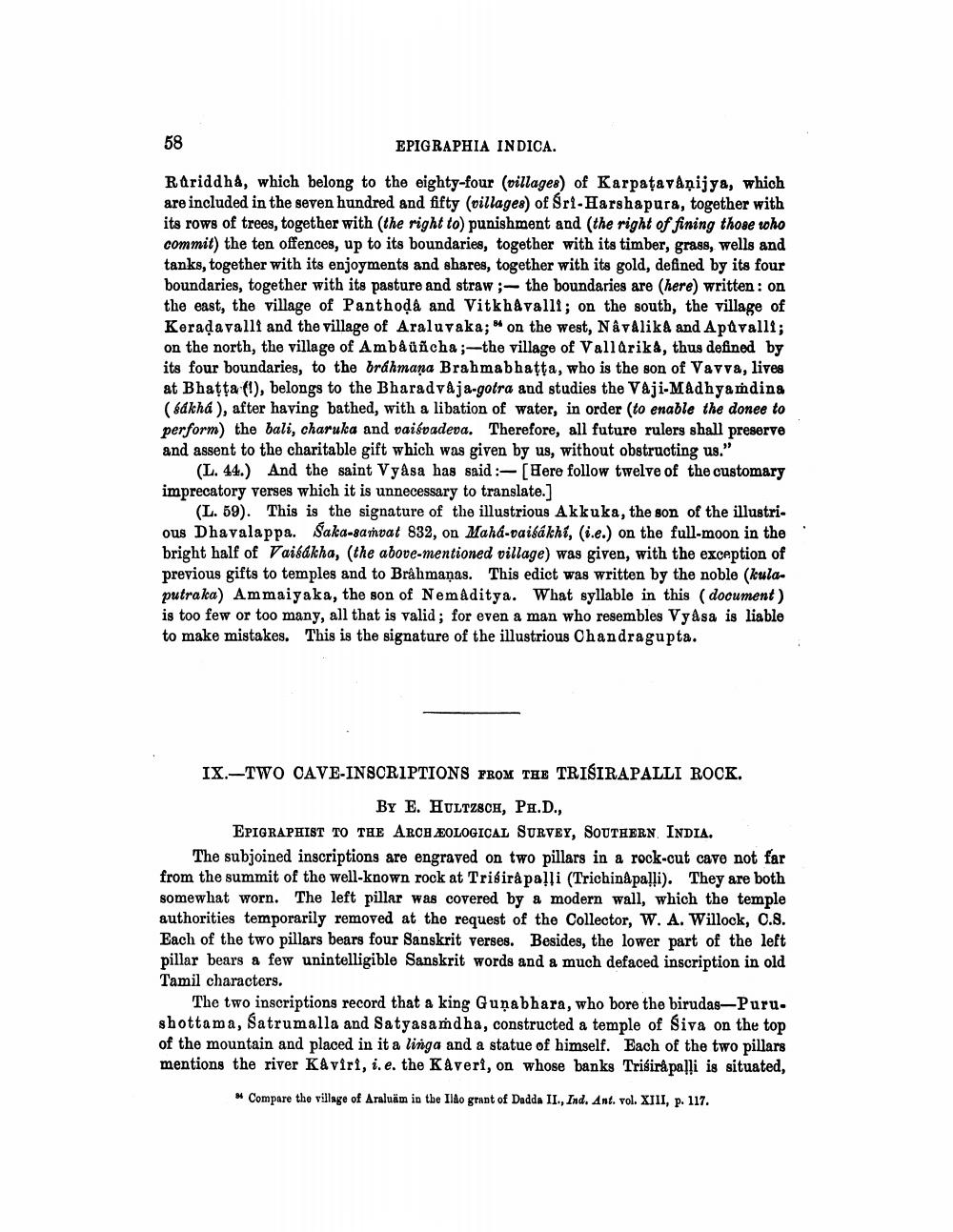________________
58
EPIGRAPHIA INDICA.
Rariddha, which belong to the eighty-four (villages) of Karpatavanijya, which are included in the seven hundred and fifty (villages) of Sri-Harshapura, together with its rows of trees, together with (the right to) punishment and (the right of fining those who commit) the ten offences, up to its boundaries, together with its timber, grass, wells and tanks, together with its enjoyments and shares, together with its gold, defined by its four boundaries, together with its pasture and straw;- the boundaries are (here) written: on the east, the village of Panthoḍa and Vitkhâvalli; on the south, the village of Koradavalli and the village of Araluvaka;" on the west, NAvAlika and Apůvalli; on the north, the village of Ambâüñcha;-the village of Vallarika, thus defined by its four boundaries, to the brahmana Brahmabhaṭṭa, who is the son of Vavva, lives at Bhatta (1), belongs to the Bharadvaja-gotra and studies the Vaji-Madhyamdins (sákhá), after having bathed, with a libation of water, in order (to enable the donee to perform) the bali, charuka and vaiśvadeva. Therefore, all future rulers shall preserve and assent to the charitable gift which was given by us, without obstructing us."
(L. 44.) And the saint Vyasa has said: [Here follow twelve of the customary imprecatory verses which it is unnecessary to translate.]
(L. 59). This is the signature of the illustrious Akkuka, the son of the illustrious Dhavalappa. Saka-samvat 832, on Mahá-vaiśákhí, (i.e.) on the full-moon in the bright half of Vaisakha, (the above-mentioned village) was given, with the exception of previous gifts to temples and to Brâhmanas. This edict was written by the noble (kulaputraka) Ammaiyaka, the son of Nemaditya. What syllable in this (document) is too few or too many, all that is valid; for even a man who resembles Vyasa is liable to make mistakes. This is the signature of the illustrious Chandragupta.
IX.-TWO CAVE-INSCRIPTIONS FROM THE TRISIRAPALLI ROCK.
BY E. HULTZSCH, PH.D.,
EPIGRAPHIST TO THE ARCHEOLOGICAL SURVEY, SOUTHERN INDIA.
The subjoined inscriptions are engraved on two pillars in a rock-cut cave not far from the summit of the well-known rock at Triśirapalli (Trichinâpalli). They are both somewhat worn. The left pillar was covered by a modern wall, which the temple authorities temporarily removed at the request of the Collector, W. A. Willock, C.S. Each of the two pillars bears four Sanskrit verses. Besides, the lower part of the left pillar bears a few unintelligible Sanskrit words and a much defaced inscription in old Tamil characters.
The two inscriptions record that a king Gunabhara, who bore the birudas-Puru. shottama, Satrumalla and Satyasamdha, constructed a temple of Siva on the top of the mountain and placed in it a linga and a statue of himself. Each of the two pillars mentions the river Kaviri, i. e. the Kaveri, on whose banks Trisirâpalli is situated,
Compare the village of Araluäm in the Ilão grant of Dadda II., Ind. Ant. vol. XIII, p. 117.




